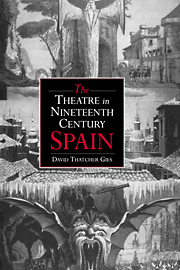Book contents
- Frontmatter
- Contents
- Preface
- Introduction: literary history and canon formation
- 1 Spanish theatre in the nineteenth century. (An overview)
- 2 Theatre and dictatorship: from Napoleon to Fernando VII
- 3 Romanticism and beyond (1834-1849)
- 4 The theatre at mid-century
- 5 “This woman is quite a man!”: women and the theatre (1838-1900)
- 6 High comedy, and low
- 7 Conflicting visions: neo-Romanticism, ridicule, and realism
- Conclusion
- Bibliography
- Index of names
- Index of plays
1 - Spanish theatre in the nineteenth century. (An overview)
Published online by Cambridge University Press: 07 May 2010
- Frontmatter
- Contents
- Preface
- Introduction: literary history and canon formation
- 1 Spanish theatre in the nineteenth century. (An overview)
- 2 Theatre and dictatorship: from Napoleon to Fernando VII
- 3 Romanticism and beyond (1834-1849)
- 4 The theatre at mid-century
- 5 “This woman is quite a man!”: women and the theatre (1838-1900)
- 6 High comedy, and low
- 7 Conflicting visions: neo-Romanticism, ridicule, and realism
- Conclusion
- Bibliography
- Index of names
- Index of plays
Summary
The century seemed to open auspiciously enough. The wars over theatrical reform waged in the eighteenth century seemed to have been won by those who demanded less censorship, more involvement by the acting companies, and better working conditions. The 1799 Idea de una reforma de los teatros de Madrid (Idea for an Improvement of the Theatres of Madrid) had been approved in November of that year and was to be put into effect for the theatrical season 1800-1801. Madrid's finest actor, Isidoro Máiquez, had gone off to Paris to study the techniques of that city's dazzling François Joseph Talma, much acclaimed for his natural acting style. Even the terrible fire that in 1802 destroyed one of the capital's main theatres, the Principe, held the possibility that with the new edifice would come a new (and enlightened) administration. Meanwhile, the enormous - and unprecedented - success of Leandro Fernández de Moratin's neoclassical comedy, El si de las niñas (The Maidens' Consent) in 1806, seemed to confirm that the curtain was going up on a new and exciting period of stability and quality for the Spanish theatre. Alas, such was not the case. The reforms of 1800 were dashed by a series of conflicting interests, Moratin's triumph produced no immediate heirs of merit, and the new Principe (opened in 1807) was placed back under the control of the Ayuntamiento (City Hall).
- Type
- Chapter
- Information
- The Theatre in Nineteenth-Century Spain , pp. 6 - 39Publisher: Cambridge University PressPrint publication year: 1994

